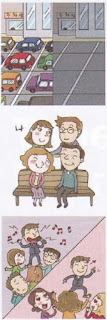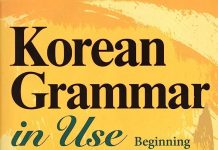 낮에는 차가 많은데 밤에는 차가 없어요.
낮에는 차가 많은데 밤에는 차가 없어요.
In the afternoon, there are a lot of cars, but at night, there aren’t any.
저는 오빠는 있는데 언니는 없어요.
I have an older brother, but not an older sister.
노래는 못하는데 춤은 잘 춰요.
I can’t sing, but I can dance well.
Grammar Focus:
은데/ㄴ데/는데 is used when the information in the second clause of the sentence is opposite of, in contrast to, or an unexpected result of what is presented in the first clause. It corresponds to ‘but’ in English. When added to an adjective ending in a vowel, -ㄴ데 is added while -은데 is added to an adjective ending in a consonant. As for present tense verbs, past tense verbs, and 있다/없다,-는데 is added.
 Conversation:
Conversation:
A: 왜 그 시장에 안 가요? Why don’t you go to that market?
B: 가격은 싼데 너무 멀어요. The prices are cheap, but it’s too far away.
A: 회사가 어때요? How’s your job at the company?
B: 일은 많은데 월급은 적어요.
There are many things to do, but the salary is small.
>> Full of ‘Korean grammar in use – Beginner’: Click here
>> Fanpage: Say Hi Korean


![[Korean grammar] ‘ㅅ’ 불규칙 (Irregular Conjugation)](https://sayhikorean.com/wp-content/uploads/2021/10/112.1.jpg)
![[Korean grammar] ‘ㅎ’ 불규칙 (Irregular Conjugation)](https://sayhikorean.com/wp-content/uploads/2021/10/111.1.jpg)
![[Korean grammar] ‘르’ 불규칙 (Irregular Conjugation)](https://sayhikorean.com/wp-content/uploads/2021/10/110.1.jpg)
![[Korean grammar] ‘ㄷ’ 불규칙 (Irregular Conjugation)](https://sayhikorean.com/wp-content/uploads/2021/10/109.1.jpg)
![[Korean grammar] ‘ㅂ’ 불규칙 (Irregular Conjugation)](https://sayhikorean.com/wp-content/uploads/2021/10/108.1.jpg)
![[Korean grammar] ‘ㄹ’ 불규칙 (Irregular Conjugation)](https://sayhikorean.com/wp-content/uploads/2021/10/107.1.jpg)
![[Korean grammar] ‘ㅡ’ 불규칙 (Irregular Conjugation)](https://sayhikorean.com/wp-content/uploads/2021/10/106.1.jpg)
![[Korean grammar] Indirect Quotation Contracted Forms: -대요, -래요, -재요, -냬요](https://sayhikorean.com/wp-content/uploads/2021/10/105.1.jpg)
![[Korean grammar] Indirect Quotations](https://sayhikorean.com/wp-content/uploads/2021/10/104.1.jpg)
![[Korean grammar] Direct Quotations: ‘Quoted speech’ + 하고/라고 + V](https://sayhikorean.com/wp-content/uploads/2021/10/103.1.jpg)
![[Korean grammar] A/V-(으)ㄴ/는데요 Additional Endings](https://sayhikorean.com/wp-content/uploads/2021/10/102.1.jpg)